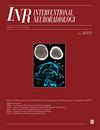通过平板血管造影 CT(FP-CT)分析脑静脉窦狭窄,指导特发性颅内高压的治疗
IF 1.7
4区 医学
Q3 Medicine
引用次数: 0
摘要
导言脑静脉窦支架植入术(CVSS)是治疗硬脑膜静脉窦狭窄继发的特发性颅内高压(IIH)的有效方法。传统的方法是通过微导管测压选择 CVSS 患者,但压力测量结果往往不准确。在此,我们展示了一系列病例的结果,在这些病例中,静脉平板 CT(FP-CT)被用作微导管测压的辅助手段,以改进 CVSS 期间的决策和精确支架置入。方法十名连续的 IIH 患者接受了血管造影、微导管测压和静脉 FP-CT,并根据结果选择了 CVSS。在支架植入前后,通过 FP-CT 对狭窄的静脉窦进行横截面测量。手术后,对临床结果进行跟踪。结果测量的压力梯度与使用静脉 FP-CT 计算的狭窄程度呈指数相关。结论静脉相 FP-CT 对硬膜窦横截面积的真实测量与狭窄点静脉压力梯度的升高高度相关。即使是在有限的一系列病例中,我们也发现随着狭窄程度的增加,血流呈指数下降。此外,FP-CT 显示静脉压力梯度升高和静脉窦临界狭窄的患者在支架植入术后症状有所改善。本文章由计算机程序翻译,如有差异,请以英文原文为准。
Analysis of cerebral venous sinus stenosis by flat panel angiographic CT (FP-CT) to guide treatment for idiopathic intracranial hypertension
IntroductionCerebral venous sinus stenting (CVSS) is an effective treatment for idiopathic intracranial hypertension (IIH) secondary to dural venous sinus stenosis. Traditional selection of patients for CVSS has been made by microcatheter manometry, but pressure measurements are often equivocal. Here we present the results of a series of cases in which venous flat-panel CT (FP-CT) was used as an adjunct to microcatheter manometry to improve decision making and precise stent placement during CVSS.MethodsTen consecutive patients with IIH underwent angiography with microcatheter manometry and venous FP-CT, with CVSS if indicated by the results. Cross-sectional measurements of the narrowed sinus were obtained on FP-CT before and after stenting. After the procedure, clinical outcomes were tracked. Follow-up with quantitative MRA with sinus flow measurements was also performed, when available.ResultsThere was an exponential correlation between measured pressure gradient and degree of stenosis calculated using venous FP-CT. All patients with both a high degree of stenosis measured by FP-CT and a high pressure gradient across the stenosis showed a clinical benefit from stenting.ConclusionsTrue measurement of the cross-sectional area of the dural sinus, made by venous phase FP-CT, has a high degree of correlation with elevated venous pressure gradient across the point of stenosis. Even in a limited series of cases, we found an exponential decrease in flow with increasing severity of stenosis. Furthermore, patients with both an elevated venous pressure gradient and critical stenosis of the sinus on FP-CT showed symptomatic improvement after stenting.
求助全文
通过发布文献求助,成功后即可免费获取论文全文。
去求助
来源期刊
CiteScore
2.80
自引率
11.80%
发文量
192
审稿时长
6-12 weeks
期刊介绍:
Interventional Neuroradiology (INR) is a peer-reviewed clinical practice journal documenting the current state of interventional neuroradiology worldwide. INR publishes original clinical observations, descriptions of new techniques or procedures, case reports, and articles on the ethical and social aspects of related health care. Original research published in INR is related to the practice of interventional neuroradiology...

 求助内容:
求助内容: 应助结果提醒方式:
应助结果提醒方式:


